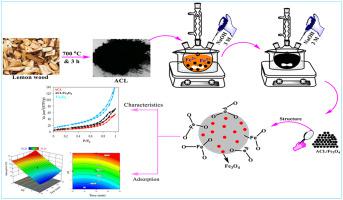Chemosphere ( IF 8.1 ) Pub Date : 2021-06-04 , DOI: 10.1016/j.chemosphere.2021.131088 Seyed Jamaleddin Peighambardoust 1 , Rauf Foroutan 1 , Seyed Hadi Peighambardoust 2 , Hamzeh Khatooni 2 , Bahman Ramavandi 3

|
In the present study, the activated carbon of lemon (ACL) was generated from Citrus limon wood waste and composited with Fe3O4 nanoparticles. The ACL/Fe3O4 magnetic composite was effectively used to eliminate Cd2+ from an aqueous solution. The active surface area values for ACL and ACL/Fe3O4 magnetic composite were 25.99 m2/g and 38.70 m2/g, respectively indicating the effectiveness of Fe3O4 nanoparticles in improving ACL active surface area. The response surface methodology with central composite design (RSM-CCD) was used to determine optimal values of pH, ACL/Fe3O4 dose, contact time, and Cd2+ concentration on the decontamination efficiency. The Langmuir and Freundlich isotherm models had more potential to describe the adsorption process using ACL and ACL/Fe3O4, respectively. The Langmuir-based adsorption capacity was obtained as 28.2 mg/g (ACL) and 39.6 mg/g (ACL/Fe3O4). A pseudo-second order (PSO) model was successfully applied to evaluate the adsorption process kinetic behavior. A higher value of α parameter for ACL/Fe3O4 (5.7 mg/g.min) than that of ACL (3.5 mg/g.min) indicated that the magnetic composite had a greater tendency to absorb Cd2+. In addition, the Weber–Morris model showed that various mechanisms such as intraparticle diffusion and boundary layer effects may have a role in the adsorption process. The study of ad(de)sorption behavior showed that the adsorbents have a good ability to adsorb Cd2+ and no significant change in their performance has been made up to 4 times of reuse. Our results showed that ACL modification using Fe3O4 nanoparticles improved the adsorption efficiency of ACL to remove Cd2+ from the aqueous solutions.
中文翻译:

用 Fe3O4 装饰柑橘木炭以增强 Cd2+ 去除:一种可回收的磁性纳米复合材料
在本研究中,柠檬活性炭 (ACL) 是从柑橘柠檬木材废料中产生的,并与 Fe 3 O 4纳米颗粒复合。ACL/Fe 3 O 4磁性复合材料有效地用于从水溶液中去除Cd 2+。ACL 和 ACL/Fe 3 O 4磁性复合材料的活性表面积值分别为 25.99 m 2 /g 和 38.70 m 2 /g,表明 Fe 3 O 4的有效性纳米粒子在改善 ACL 活性表面积方面的作用。采用中心复合设计的响应面方法 (RSM-CCD) 用于确定 pH、ACL/Fe 3 O 4剂量、接触时间和 Cd 2+浓度对去污效率的最佳值。Langmuir 和 Freundlich 等温线模型分别具有更大的潜力来描述使用 ACL 和 ACL/Fe 3 O 4的吸附过程。获得的基于朗缪尔的吸附容量为 28.2 mg/g (ACL) 和 39.6 mg/g (ACL/Fe 3 O 4 )。伪二级(PSO)模型成功应用于评估吸附过程动力学行为。ACL/Fe 3的 α 参数值更高O 4 (5.7 mg/g.min) 比ACL (3.5 mg/g.min) 表明磁性复合材料具有更大的吸收Cd 2+ 的趋势。此外,Weber-Morris 模型表明颗粒内扩散和边界层效应等各种机制可能在吸附过程中起作用。对吸附(解)吸行为的研究表明,该吸附剂对Cd 2+具有良好的吸附能力,经4次重复使用后,其性能无明显变化。我们的结果表明,使用 Fe 3 O 4纳米颗粒进行 ACL 改性提高了 ACL从水溶液中去除 Cd 2+的吸附效率。









































 京公网安备 11010802027423号
京公网安备 11010802027423号